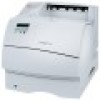Lexmark T620 Service Manual - Page 203
Autoconnect System, Paper Tray Options, Envelope Feeder and Output Expander, Operations, Electrical
 |
View all Lexmark T620 manuals
Add to My Manuals
Save this manual to your list of manuals |
Page 203 highlights
4069-5XX/7XX are driven down into the stack increasing the normal force and drive force until the bending strength of the paper is overcome and the paper bends and moves up the dam. Once this critical threshold is achieved the normal force remains at a level just high enough to reliably feed the paper. Rather than having a fixed spring force for feeding all weights of paper like the D-roll, this device has its own mechanical logic for producing only enough pick energy to feed a single sheet of paper regardless of its stiffness. High normal force is one of the most significant contributors to double feeding paper. The pick arm is counter balanced by an extension spring located on the pick arm to reduce weight in the rest state. This spring is factory set to exert no more than ten to fifteen grams on the stack. This is as light as can be realistically set and always guarantee there is some force to start the auto compensating phenomena. This spring is not to be considered an adjustment for feeding problems unless it is obvious that the pick arm cannot fall all the way down to the bottom of the tray or has come loose. Poor gear efficiency can cause the arm to generate higher normal forces. If the pick assembly is noisy, replacement may be required. The arm must pivot freely through its full range of motion. On 500 sheet trays there are wrap springs located on the pivot arbors of the arm. These springs aid to prevent the arm from bouncing. If the arm appears to be binding or sticky near the bottom of the tray these springs may be the problem. Reducing the tension on the counterbalance spring may be used as a temporary fix to get additional weight at bottom, until the pick assembly can be replaced. However, the counterbalance spring is not to be considered an adjustment for feeding problems. Autoconnect System, Paper Tray Options, Envelope Feeder and Output Expander Operations Electrical Autoconnect Cabling and Connectors The printer options make electrical connection automatically or autoconnects requiring no external cables when the option is Diagnostic Aids 3-37















